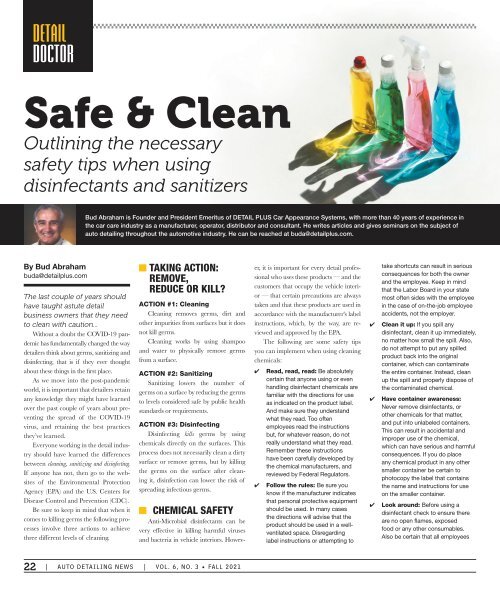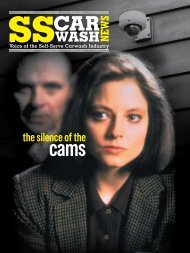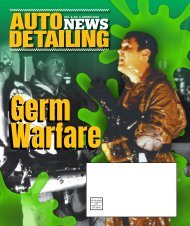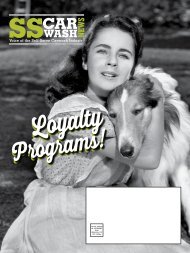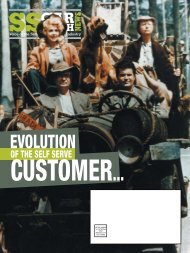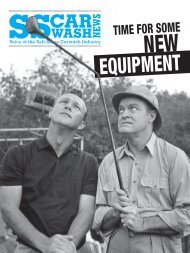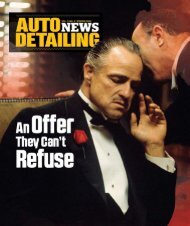2021_ADN_V6_No3_web
Create successful ePaper yourself
Turn your PDF publications into a flip-book with our unique Google optimized e-Paper software.
DETAIL<br />
DOCTOR<br />
Safe & Clean<br />
Outlining the necessary<br />
safety tips when using<br />
disinfectants and sanitizers<br />
Bud Abraham is Founder and President Emeritus of DETAIL PLUS Car Appearance Systems, with more than 40 years of experience in<br />
the car care industry as a manufacturer, operator, distributor and consultant. He writes articles and gives seminars on the subject of<br />
auto detailing throughout the automotive industry. He can be reached at buda@detailplus.com.<br />
By Bud Abraham<br />
buda@detailplus.com<br />
The last couple of years should<br />
have taught astute detail<br />
business owners that they need<br />
to clean with caution...<br />
Without a doubt the COVID-19 pandemic<br />
has fundamentally changed the way<br />
detailers think about germs, sanitizing and<br />
disinfecting, that is if they ever thought<br />
about these things in the first place.<br />
As we move into the post-pandemic<br />
world, it is important that detailers retain<br />
any knowledge they might have learned<br />
over the past couple of years about preventing<br />
the spread of the COVID-19<br />
virus, and retaining the best practices<br />
they’ve learned.<br />
Everyone working in the detail industry<br />
should have learned the differences<br />
between cleaning, sanitizing and disinfecting.<br />
If anyone has not, then go to the <strong>web</strong>sites<br />
of the Environmental Protection<br />
Agency (EPA) and the U.S. Centers for<br />
Disease Control and Prevention (CDC).<br />
Be sure to keep in mind that when it<br />
comes to killing germs the following processes<br />
involve three actions to achieve<br />
three different levels of cleaning.<br />
TAKING ACTION:<br />
REMOVE,<br />
REDUCE OR KILL?<br />
ACTION #1: Cleaning<br />
Cleaning removes germs, dirt and<br />
other impurities from surfaces but it does<br />
not kill germs.<br />
Cleaning works by using shampoo<br />
and water to physically remove germs<br />
from a surface.<br />
ACTION #2: Sanitizing<br />
Sanitizing lowers the number of<br />
germs on a surface by reducing the germs<br />
to levels considered safe by public health<br />
standards or requirements.<br />
ACTION #3: Disinfecting<br />
Disinfecting kills germs by using<br />
chemicals directly on the surfaces. This<br />
process does not necessarily clean a dirty<br />
surface or remove germs, but by killing<br />
the germs on the surface after cleaning<br />
it, disinfection can lower the risk of<br />
spreading infectious germs.<br />
CHEMICAL SAFETY<br />
Anti-Microbial disinfectants can be<br />
very effective in killing harmful viruses<br />
and bacteria in vehicle interiors. However,<br />
it is important for every detail professional<br />
who uses these products — and the<br />
customers that occupy the vehicle interior<br />
— that certain precautions are always<br />
taken and that these products are used in<br />
accordance with the manufacturer's label<br />
instructions, which, by the way, are reviewed<br />
and approved by the EPA.<br />
The following are some safety tips<br />
you can implement when using cleaning<br />
chemicals:<br />
✔<br />
✔<br />
Read, read, read: Be absolutely<br />
certain that anyone using or even<br />
handling disinfectant chemicals are<br />
familiar with the directions for use<br />
as indicated on the product label.<br />
And make sure they understand<br />
what they read. Too often<br />
employees read the instructions<br />
but, for whatever reason, do not<br />
really understand what they read.<br />
Remember these instructions<br />
have been carefully developed by<br />
the chemical manufacturers, and<br />
reviewed by Federal Regulators.<br />
Follow the rules: Be sure you<br />
know if the manufacturer indicates<br />
that personal protective equipment<br />
should be used. In many cases<br />
the directions will advise that the<br />
product should be used in a wellventilated<br />
space. Disregarding<br />
label instructions or attempting to<br />
✔<br />
✔<br />
✔<br />
take shortcuts can result in serious<br />
consequences for both the owner<br />
and the employee. Keep in mind<br />
that the Labor Board in your state<br />
most often sides with the employee<br />
in the case of on-the-job employee<br />
accidents, not the employer.<br />
Clean it up: If you spill any<br />
disinfectant, clean it up immediately,<br />
no matter how small the spill. Also,<br />
do not attempt to put any spilled<br />
product back into the original<br />
container, which can contaminate<br />
the entire container. Instead, clean<br />
up the spill and properly dispose of<br />
the contaminated chemical.<br />
Have container awareness:<br />
Never remove disinfectants, or<br />
other chemicals for that matter,<br />
and put into unlabeled containers.<br />
This can result in accidental and<br />
improper use of the chemical,<br />
which can have serious and harmful<br />
consequences. If you do place<br />
any chemical product in any other<br />
smaller container be certain to<br />
photocopy the label that contains<br />
the name and instructions for use<br />
on the smaller container.<br />
Look around: Before using a<br />
disinfectant check to ensure there<br />
are no open flames, exposed<br />
food or any other consumables.<br />
Also be certain that all employees<br />
22 | AUTO DETAILING NEWS | VOL. 6, NO. 3 • FALL <strong>2021</strong>


